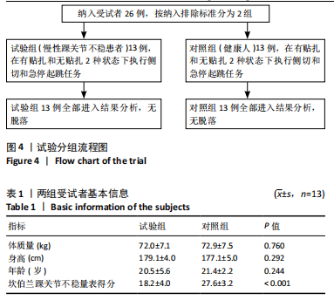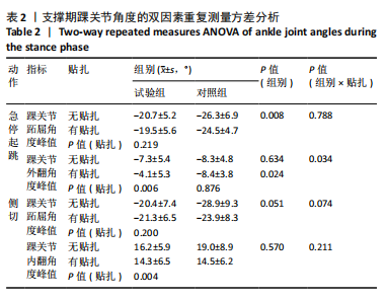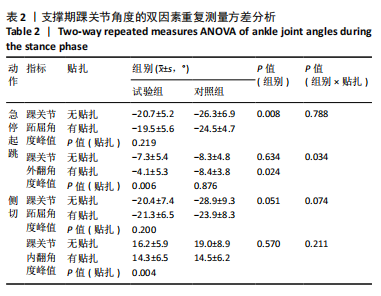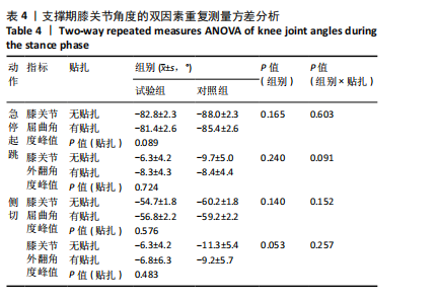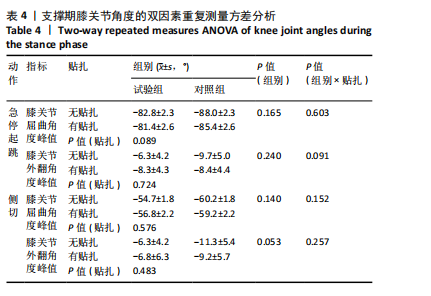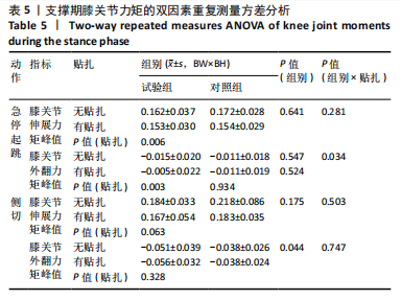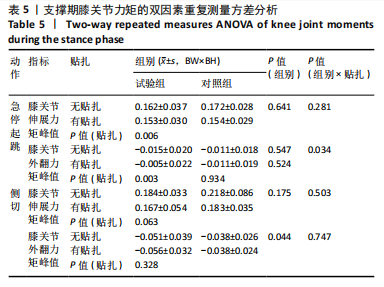Chinese Journal of Tissue Engineering Research ›› 2026, Vol. 30 ›› Issue (10): 2422-2429.doi: 10.12307/2026.638
Previous Articles Next Articles
Effects of ankle taping on knee and ankle biomechanics of individuals with chronic ankle instability in the side-cutting and stop-jumping tasks
Li Xinke1, Feng Ru1, Rong Ke1, Sun Xiaole1, Zhou Zhipeng2, Yang Chen1
- 1Nanjing Sport Institute, Nanjing 210014, Jiangsu Province, China; 2Shandong Sport University, Jinan 250102, Shandong Province, China
-
Received:2025-03-06Accepted:2025-06-18Online:2026-04-08Published:2025-08-27 -
Contact:Yang Chen, PhD, Associate professor, Nanjing Sport Institute, Nanjing 210014, Jiangsu Province, China -
About author:Li Xinke, MS candidate, Nanjing Sport Institute, Nanjing 210014, Jiangsu Province, China -
Supported by:Science and Technology Innovation Project of General Administration of Sport of China, No. 23KJCX032 (to YC); 2023 “Qinglan Project” of Jiangsu Universities (to YC)
CLC Number:
Cite this article
Li Xinke, Feng Ru, Rong Ke, Sun Xiaole, Zhou Zhipeng, Yang Chen. Effects of ankle taping on knee and ankle biomechanics of individuals with chronic ankle instability in the side-cutting and stop-jumping tasks[J]. Chinese Journal of Tissue Engineering Research, 2026, 30(10): 2422-2429.
share this article
Add to citation manager EndNote|Reference Manager|ProCite|BibTeX|RefWorks
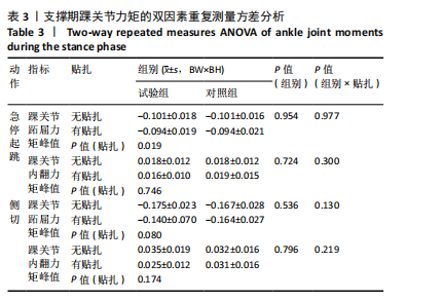
双因素重复测量方差分析显示组别和贴扎对急停起跳支撑期踝关节跖屈角度峰值(P=0.788)和侧切支撑期踝关节内翻角度峰值(P=0.211)均无交互作用,有贴扎时侧切踝关节内翻角度小于无贴扎(P=0.004),试验组急停起跳踝关节跖屈角度小于对照组(P=0.008)。 双因素重复测量方差分析显示组别和贴扎对急停起跳和侧切支撑期其他踝关节角度均无交互作用(P≥0.074),且贴扎和组别的主效应均不存在显著影响(P≥0.051)。 如表3所示,双因素重复测量方差分析显示组别和贴扎对急停起跳支撑期踝关节跖屈力矩峰值(P=0.977)无交互作用,有贴扎时急停起跳踝关节跖屈力矩小于无贴扎(P=0.019)。"
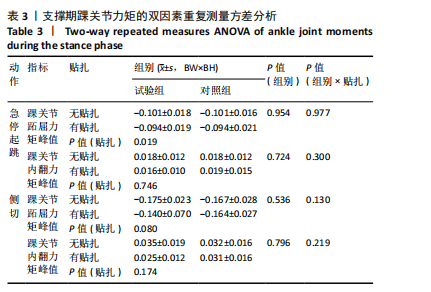

有贴扎时膝关节外翻力矩小于无贴扎(P=0.003),贴扎未对对照组产生影响(P=0.934),有、无贴扎时组别间均无显著性差异(P=0.547,P=0.524)。 双因素重复测量方差分析显示组别和贴扎对急停起跳支撑期膝关节伸展力矩峰值(P=0.281)和侧切支撑期膝关节外翻力矩峰值(P=0.747)均无交互作用,有贴扎时急停起跳膝关节伸展力矩小于无贴扎(P=0.006),试验组侧切膝关节外翻力矩大于对照组(P=0.044)。 双因素重复测量方差分析显示组别和贴扎对急停起跳和侧切支撑期其他膝关节力矩均无交互作用(P≥0.203),且贴扎和组别的主效应均不存在显著影响(P≥0.063)。 2.6 不良事件 两组受试者均未发生与运动试验相关的不良事件,皮肤膜与白贴未引发炎症过敏等不良反应。"

| [1] MCKAY GD, GOLDIE PA, PAYNE WR, et al. Ankle injuries in basketball: injury rate and risk factors. Br J Sports Med. 2001;35(2):103-108. [2] 张泽毅, 刘卉, 张美珍, 等. FAI和Coper患者踝关节扭伤相关动作中的下肢运动生物力学特征[J]. 中国体育科技,2023,59(8):47-55. [3] SARCON AK, HEYRANI N, GIZA E, et al. Lateral Ankle Sprain and Chronic Ankle Instability. Foot Ankle Orthop. 2019;4(2):1-10. [4] 文子良, 郑兵, 朱江, 等. 慢性踝关节不稳的康复功能评定研究进展[J]. 中国康复医学杂志,2023,38(6):845-850. [5] 章丽莉,杨玉珊.慢性踝关节不稳姿势稳定性的研究进展[J]. 中国康复理论与实践,2019,25(8):908-912. [6] 王颉, 周游. 踝关节扭伤模型及相关危险因素研究进展[J]. 中国运动医学杂志,2024,43(2):142-148. [7] DOHERTY C, BLEAKLEY C, DELAHUNT E, et al. Treatment and prevention of acute and recurrent ankle sprain: an overview of systematic reviews with meta-analysis. Br J Sports Med. 2017;51(2):113-125. [8] PELLOW JE, BRANTINGHAM JW. The efficacy of adjusting the ankle in the treatment of subacute and chronic grade I and grade II ankle inversion sprains. J Manipulative Physiol Ther. 2001;24(1):17-24. [9] TANG Y, LIANG P, PAN J, et al. Effects of Ankle Orthoses, Taping, and Insoles on Postural Stability of Individuals with Chronic Ankle Instability: A Systematic Review. Healthcare (Basel). 2023;11(18):570. [10] DIZON JMR, REYES JJB. A systematic review on the effectiveness of external ankle supports in the prevention of inversion ankle sprains among elite and recreational players. J Sci Med Sport. 2010;13(3): 309-317. [11] ROWE PL, BRYANT AL, EGERTON T, et al. External Ankle Support and Ankle Biomechanics in Chronic Ankle Instability: Systematic Review and Meta-Analysis. J Athl Train. 2023;58(7-8):635-647. [12] 邓发伟, 崔芳, 毕然然, 等. 物理治疗改善慢性踝关节不稳患者踝关节活动受限的研究进展[J]. 中国骨与关节损伤杂志,2022,37(2): 221-224. [13] UTKU B, BÄHR G, KNOKE H, et al. The effect of fresh and used ankle taping on lower limb biomechanics in sports specific movements. J Sci Med Sport. 2024;27(11):772-778. [14] WILLIAMS SA, NG L, STEPHENS N, et al. Effect of prophylactic ankle taping on ankle and knee biomechanics during basketball-specific tasks in females. Phys Ther Sport. 2018;32:200-206. [15] 姚军威, 程阳, 韦俏丽, 等. 贴扎对慢性踝关节不稳的男性篮球运动员正向和侧向跳跃时踝关节运动学特征的影响[J]. 中华物理医学与康复杂志,2023,45(1):53-60. [16] ZWIERS R, VUURBERG G, BLANKEVOORT L, et al. Taping and bracing in the prevention of ankle sprains: current concepts. J ISAKOS. 2016;1(6): 304-310. [17] SARVESTAN J, SVOBODA Z. Acute Effect of Ankle Kinesio and Athletic Taping on Ankle Range of Motion During Various Agility Tests in Athletes With Chronic Ankle Sprain. J Sport Rehabil. 2020;29(5):527-532. [18] DELTOUR C, DINGENEN B, STAES F, et al. Preliminary Evidence That Taping Does Not Optimize Joint Coupling of the Foot and Ankle Joints in Patients with Chronic Ankle Instability. Int J Environ Res Public Health. 2021;18(4):2029. [19] SHAMSODDINI A, HOLLISAZ MT. Biomechanics of running: A special reference to the comparisons of wearing boots and running shoes. PLoS One. 2022;17(6):e0270496. [20] SANTOS MJ, MCINTIRE K, FOECKING J, et al. The effects of ankle bracing on motion of the knee and the hip joint during trunk rotation tasks. Clin Biomech (Bristol). 2004;19(9):964-971. [21] KLEM NR, WILD CY, WILLIAMS SA, et al. Effect of External Ankle Support on Ankle and Knee Biomechanics During the Cutting Maneuver in Basketball Players. Am J Sports Med. 2017;45(3):685-691. [22] RIEMANN BL, SCHMITZ RJ, GALE M, et al. Effect of ankle taping and bracing on vertical ground reaction forces during drop landings before and after treadmill jogging. J Orthop Sports Phys Ther. 2002;32(12): 628-635. [23] CORDOVA ML, TAKAHASHI Y, KRESS GM, et al. Influence of external ankle support on lower extremity joint mechanics during drop landings. J Sport Rehabil. 2010;19(2):136-148. [24] DE RIDDER R, WILLEMS T, VANRENTERGHEM J, et al. Taping benefits ankle joint landing kinematics in individuals with chronic ankle instability. J Sport Rehabil. 2020; 29(2): 162-167. [25] 李淑媛, 朱磊, 张亚楠, 等. Cumberland踝关节不稳定评定问卷的汉化与信度、效度分析[J]. 中国运动医学杂志,2011,30(9):814-819. [26] WILKERSON GB. Comparative biomechanical effects of the standard method of ankle taping and a taping method designed to enhance subtalar stability. Am J Sports Med. 1991;19(6):588-595. [27] ABIÁN-VICÉN J, ALEGRE LM, FERNÁNDEZ-RODRÍGUEZ JM, et al. Ankle taping does not impair performance in jump or balance tests. J Sports Sci Med. 2008;7(3):350-356. [28] 周志鹏, 郑亮亮, 孙萌梓, 等. 鞋帮高度对踝关节不稳者侧切动作下肢生物力学特征的影响[J]. 中国运动医学杂志,2021,40(5):352-359. [29] YU B, GABRIEL D, NOBLE L, et al. Estimate of the Optimum Cutoff Frequency for the Butterworth Low-Pass Digital Filter. J Appl Biomech. 1999;15(3):318-329. [30] BELL AL, BRAND RA, PEDERSEN DR. Prediction of hip joint centre location from external landmarks. Hum Mov Sci. 1989;8(1):3-16. [31] WINTER DA. Three-Dimensional Kinematics and Kinetics//Biomechanics and Motor Control of Human Movement. John Wiley & Sons, Ltd, 2009: 176-199. [32] WEST T, NG L, CAMPBELL A. The effect of ankle bracing on knee kinetics and kinematics during volleyball‐specific tasks. Scand J Med Sci Sports. 2014;24(6):958-963. [33] STOFFEL KK, NICHOLLS RL, WINATA AR, et al. Effect of Ankle Taping on Knee and Ankle Joint Biomechanics in Sporting Tasks. Med Sci Sports Exerc. 2010;42(11):2089-2097. [34] XIE D, URABE Y, OCHIAI J, et al. Sidestep cutting maneuvers in female basketball players: Stop phase poses greater risk for anterior cruciate ligament injury. Knee. 2013;20(2):85-89. [35] BURNHAM BR, COPLEY GB, SHIM MJ, et al. Mechanisms of Basketball Injuries Reported to the HQ Air Force Safety Center: A 10-Year Descriptive Study, 1993–2002. Am J Prev Med. 2010;38(1):S134-S140. [36] CHERAGHI M, BOOZARI S, SVOBODA Z, et al. Effects of ankle KinesioTM taping on jump biomechanics in collegiate athletes with chronic ankle instability. Sport Sci Health. 2022;18(3):839-846. [37] KUNI B, MUSSLER J, KALKUM E, et al. Effect of kinesiotaping, non-elastic taping and bracing on segmental foot kinematics during drop landing in healthy subjects and subjects with chronic ankle instability. Phys Ther. 2016;102(3):287-293. [38] FUERST P, GOLLHOFER A, WENNING M, et al. People with chronic ankle instability benefit from brace application in highly dynamic change of direction movements. J Foot Ankle Res. 2021;14(1):13. [39] GEHRING D, WISSLER S, LOHRER H, et al. Expecting ankle tilts and wearing an ankle brace influence joint control in an imitated ankle sprain mechanism during walking. Gait Posture. 2014;39(3):894-898. [40] LIN JZ, LIN YA, LEE HJ. Are Landing Biomechanics Altered in Elite Athletes with Chronic Ankle Instability. J Sports Sci Med. 2019;18(4): 653-662. [41] DE RIDDER R, WILLEMS T, VANRENTERGHEM J, et al. Multi-segment foot landing kinematics in subjects with chronic ankle instability. Clin Biomech (Bristol). 2015;30(6):585-592. [42] STOTZ A, JOHN C, GMACHOWSKI J, et al. Effects of elastic ankle support on running ankle kinematics in individuals with chronic ankle instability and healthy controls. Gait Posture. 2021;87:149-155. [43] 冯俊钢. 超重男性大学生惯用侧踝关节贴扎前后单腿跳落地下肢主要关节生物力学特征研究[D]. 武汉:武汉体育学院,2023. [44] JUN H, CHOI S, CHANG E, et al. Influence of Prophylactic Ankle Tapes on Lower Extremity Kinematics during Stop-jump in Chronic Ankle Instability. J Men’s Health. 2021;17(4):255-263. [45] TANG M. 胶原、骨骼与骨关节[J]. 明胶科学与技术,2012,32(2):80-85. [46] MANAL K, GARDINIER E, BUCHANAN TS, et al. A more informed evaluation of medial compartment loading: the combined use of the knee adduction and flexor moments. Osteoarthritis Cartilage. 2015; 23(7):1107-1111. [47] DERRICK TR, VAN DEN BOGERT AJ, CEREATTI A, et al. ISB recommendations on the reporting of intersegmental forces and moments during human motion analysis. J Biomech. 2020;99:109533. [48] BENDJABALLAH MZ, SHIRAZI-ADL A, ZUKOR DJ. Finite element analysis of human knee joint in varus-valgus. Clinical Biomechanics (Bristol, Avon). 1997;12(3):139-148. [49] SON SJ, KIM H, SEELEY MK, et al. Movement Strategies among Groups of Chronic Ankle Instability, Coper, and Control. Med Sci Sports Exerc. 2017;49(8):1649-1661. |
| [1] | Zhong Caihong, Xiao Xiaoge, Li Ming, Lin Jianhong, Hong Jing. Biomechanical mechanism of sports-related patellar tendinitis [J]. Chinese Journal of Tissue Engineering Research, 2026, 30(6): 1417-1423. |
| [2] | Li Linzhen, Jiao Hongzhuo, Chen Weinan, Zhang Mingzhe, Wang Jianlong, Zhang Juntao. Effect of icariin-containing serum on lipopolysaccharide-induced inflammatory damage in human chondrocytes [J]. Chinese Journal of Tissue Engineering Research, 2026, 30(6): 1368-1374. |
| [3] | Zhou Jian, Zhang Tao, Zhou Weili, Zhao Xingcheng, Wang Jun, Shen Jie, Qian Li, Lu Ming. Effects of resistance training on quadriceps mass and knee joint function in patients with osteoporosis and sarcopenia [J]. Chinese Journal of Tissue Engineering Research, 2026, 30(5): 1081-1088. |
| [4] | Gu Fucheng, Yang Meixin, Wu Weixin, Cai Weijun, Qin Yangyi, Sun Mingyi, Sun Jian, Geng Qiudong, Li Nan. Effects of Guilu Erxian Glue on gut microbiota in rats with knee osteoarthritis: machine learning and 16S rDNA analysis [J]. Chinese Journal of Tissue Engineering Research, 2026, 30(4): 1058-1072. |
| [5] | Guo Zicheng, Meng Jingyuan, Zhang Jiechao, Ding Li, Tang Xiaoye, Tian Lichao, Wang Yilin, He Yong. Differences in scapular kinematics between healthy individuals and rotator cuff tear patients based on biplane X-ray [J]. Chinese Journal of Tissue Engineering Research, 2026, 30(3): 652-660. |
| [6] | Zhang Anqi, Hua Haotian, Cai Tianyuan, Wang Zicheng, Meng Zhuo, Zhan Xiaoqian, Chen Guoqian . Pain after total knee arthroplasty: current status and trend analysis [J]. Chinese Journal of Tissue Engineering Research, 2026, 30(3): 795-804. |
| [7] | Li Xiaomin, Tian Xiangdong, Wang Chaolu. High tibial osteotomy on a single plane: femorofibular angle as a reference marker for mechanical axis correction [J]. Chinese Journal of Tissue Engineering Research, 2026, 30(3): 570-576. |
| [8] | Zhou Feng, Fu Pengfei, Qian Yufan, Xu Pingcheng, Guo Jiongjiong, Zhang Lei. Correlation between spinal sagittal imbalance and knee joint parameters detected by whole-body EOS imaging [J]. Chinese Journal of Tissue Engineering Research, 2026, 30(3): 596-603. |
| [9] | Guo Jingwen, Wang Qingwei, He Zijun, Hu Zihang, Chen Zhi, Zhu Rong, Wang Yuming, Liu Wenfei, Luo Qinglu. Intra-articular injection of different concentrations of silicon-based bioceramics in treatment of knee osteoarthritis in rats [J]. Chinese Journal of Tissue Engineering Research, 2026, 30(2): 288-295. |
| [10] | Zhou Jinhai, Li Jiangwei, Wang Xuquan, Zhuang Ying, Zhao Ying, Yang Yuyong, Wang Jiajia, Yang Yang, Zhou Shilian. Three-dimensional finite element analysis of anterior femoral notching during total knee arthroplasty at different bone strengths [J]. Chinese Journal of Tissue Engineering Research, 2025, 29(9): 1775-1782. |
| [11] | Liu Yan, Wang Kai, Wu Min. Relationship between coronal angle fluctuation of ankle point and recovery of joint function after ankle fracture [J]. Chinese Journal of Tissue Engineering Research, 2025, 29(9): 1820-1826. |
| [12] | Zhu Xiaoxue, Zhao Qiongqiu, Zhang Teng, Wang Dan, Qiu Jihong, Song Qipeng, Shen Peixin. Increasing toe-out angle during drop-landing can diminish risk of inversion injuries among individuals with chronic ankle instability [J]. Chinese Journal of Tissue Engineering Research, 2025, 29(9): 1827-1833. |
| [13] | Ma Chi, Wang Ning, Chen Yong, Wei Zhihan, Liu Fengji, Piao Chengzhe. Application of 3D-printing patient-specific instruments combined with customized locking plate in opening wedge high tibial osteotomy [J]. Chinese Journal of Tissue Engineering Research, 2025, 29(9): 1863-1869. |
| [14] | Zhang Xinxin, Gao Ke, Xie Shidong, Tuo Haowen, Jing Feiyue, Liu Weiguo. Network meta-analysis of non-surgical treatments for foot and ankle ability and dynamic balance in patients with chronic ankle instability [J]. Chinese Journal of Tissue Engineering Research, 2025, 29(9): 1931-1944. |
| [15] | Sun Yundi, Cheng Lulu, Wan Haili, Chang Ying, Xiong Wenjuan, Xia Yuan. Effect of neuromuscular exercise for knee osteoarthritis pain and function: a meta-analysis [J]. Chinese Journal of Tissue Engineering Research, 2025, 29(9): 1945-1952. |
| Viewed | ||||||
|
Full text |
|
|||||
|
Abstract |
|
|||||
